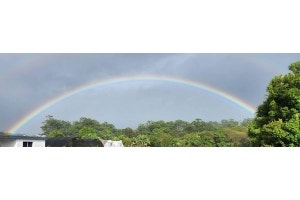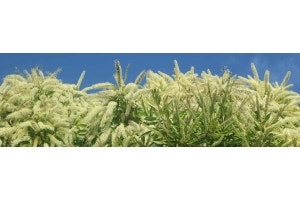
Callistemon - native bottlebrush
Callistemon - commonly called bottlebrush - is one of the most popular native plants in Australia. There's a lot of variety in colour and size; they flower from a young age so you don't need to wait long after planting for a result; they are bright and showy; the birds and butterflies love the nectar-rich blooms; and they are pretty adaptable as to soil and climate, easier to grow than many Aussie native plants.Viminalis or Citrinus - which is better?
 There are two main species of ornamental Callistemon found in Australian gardens - Callistemon viminalis, and Callistemon citrinus. Both are generous with their bottlebrush flowers, which first appear towards the beginning of spring when wildlife is in need of nectar, and continue into summer. When callistemons flower can depend on the local climate, with milder conditions bringing on earlier blooms. Several callistemons will flower more than once during the year - including both viminalis and citrinus types.Growing in reasonably similar kinds of location and climate, from light overnight frost to mild humidity, both suit most Australian gardens. Planted together, viminalis and citrinus make excellent companions for each other and for a wider selection of native plants.
There are two main species of ornamental Callistemon found in Australian gardens - Callistemon viminalis, and Callistemon citrinus. Both are generous with their bottlebrush flowers, which first appear towards the beginning of spring when wildlife is in need of nectar, and continue into summer. When callistemons flower can depend on the local climate, with milder conditions bringing on earlier blooms. Several callistemons will flower more than once during the year - including both viminalis and citrinus types.Growing in reasonably similar kinds of location and climate, from light overnight frost to mild humidity, both suit most Australian gardens. Planted together, viminalis and citrinus make excellent companions for each other and for a wider selection of native plants.
Callistemon viminalis - for warmer humid climates
 Callistemon viminalis - the wild species form found in nature - is sometimes called the weeping bottlebrush. Viminalis means "having long flexible shoots like a willow, suitable for wickerwork". It's a smaller-sized tree with scarlet-vermilion brushes of flowers; impressive, but small enough for suburban gardens. The foliage is soft and flexible, often slightly hairy, and soft-to-touch. That makes it a good choice if you have small children playing in your garden.
Callistemon viminalis - the wild species form found in nature - is sometimes called the weeping bottlebrush. Viminalis means "having long flexible shoots like a willow, suitable for wickerwork". It's a smaller-sized tree with scarlet-vermilion brushes of flowers; impressive, but small enough for suburban gardens. The foliage is soft and flexible, often slightly hairy, and soft-to-touch. That makes it a good choice if you have small children playing in your garden.
In its wild species form, viminalis is found growing from NSW right up the east coast to Cape York at the top of Far North Queensland. It's also found in locations on the west coast too.
As you might expect, this Callistemon is more heat tolerant, and can cope with humidity better. It's more frost tender, appreciating a sheltered sunny spot to grow in out of chilling winds.
 Callistemon viminalis is generally pretty rugged, growing in wet or heavy soils, in areas that get seasonal flooding, and in shady places. It's a ripper native for bank-binding and reducing soil erosion.
Callistemon viminalis is generally pretty rugged, growing in wet or heavy soils, in areas that get seasonal flooding, and in shady places. It's a ripper native for bank-binding and reducing soil erosion.
Callistemon viminalis is also pollution tolerant, which makes it an ideal street tree, and a good choice for urban locations and roadsides. What it doesn't like is salt in the soil, so avoid these varieties if you have a front-line coastal garden lashed by sea spray; or you regularly irrigate with water that has a high salt content.
Viminalis the parent
 Callistemon viminalis is the parent plant of many of the most popular bottlebrushes grown in Aussie gardens.Several of these viminalis hybrids and cultivars are tall trees, like the parent form, or large bushes with the same distinctive weeping habit. Lots have abundant big bushy red flowers; some sport those bright bottlebrushes on very petite plants!
Callistemon viminalis is the parent plant of many of the most popular bottlebrushes grown in Aussie gardens.Several of these viminalis hybrids and cultivars are tall trees, like the parent form, or large bushes with the same distinctive weeping habit. Lots have abundant big bushy red flowers; some sport those bright bottlebrushes on very petite plants!
Viminalis varieties include, in height order:
- Better John, Green John, Little John
- Little Caroline, Little Silver
- Scarlet Flame
- Rose Opal
- Captain Cook
- Macarthur
- Wildfire
- Red Alert
- Slim
- Hannah Ray, Prolific, Dawson River Weeper

Callistemon citrinus - for cooler climates
Callistemon citrinus has foliage that is stiffer and more rigid than viminalis - not sharp or harmful, but not soft-to-touch. It's said to smell of lemon - hence citr(in)us - when crushed, which gives it its other name of lemon bottlebrush.The branches tend to be more upright too, not weeping like viminialis. In its wild species form is found growing around Australia, though not as far north as viminalis.As you might expect, this Callistemon is more cold tolerant, although too much cold can reduce the amount of flowering. Callistemon citrinus is generally pretty rugged, growing in wet soils.

Callistemon citrinus benefits from pruning after spring flowering (or after autumn flowering in frost free climates) to shape the plant and encourage more flowering shoots to develop.
Callistemon citrinus varieties include many colourful pink and white varieties, as well as the classic red bottlebrush flowers:
- Burgundy
- Endeavour
- Pink Champagne
- Wilderness White, White Anzac
Callistemon species, less well known
Callistemon salignus - pink tips
 You might see Callistemon salignus, in the wild a tall, slender, somewhat leggy tree, that gets its common name of pink tips from the deep rose-pink colour of the new leaves that emerge in early spring. The creamy-white small bottlebrush flowers appear on the ends of the slightly weeping stems, fading to gold as they age. The tree gets its botanic name salignus from Salix, the true willow, for its long flexible weeping branches.
You might see Callistemon salignus, in the wild a tall, slender, somewhat leggy tree, that gets its common name of pink tips from the deep rose-pink colour of the new leaves that emerge in early spring. The creamy-white small bottlebrush flowers appear on the ends of the slightly weeping stems, fading to gold as they age. The tree gets its botanic name salignus from Salix, the true willow, for its long flexible weeping branches.
Callistemon salignus is a lovely tree for acreage where it attracts native birds and other nectar feeders; it should be avoided close to buildings as its roots can be invasive. Happy in dry climates, waterlogged soils, and full sun, it grows in most places that are frost-free.
 Callistemon salignus is the parent plant of the very popular and extremely showy Great Balls of Fire, a much smaller plant bred for hedging and feature planting. GBOF, as we affectionately know it on the nursery, pumps out masses of long slender pink-coral leaves after every clipping. It's a variety that we grow happily in our Sunshine Coast nursery without supplementary irrigation. It's very popular for parks and gardens planting locally too, as it's so resilient and colourful.Great Balls of Fire is also salt tolerant, very useful for frontline coastal gardens that are drenched in sea spray; or where irrigation water is saline.
Callistemon salignus is the parent plant of the very popular and extremely showy Great Balls of Fire, a much smaller plant bred for hedging and feature planting. GBOF, as we affectionately know it on the nursery, pumps out masses of long slender pink-coral leaves after every clipping. It's a variety that we grow happily in our Sunshine Coast nursery without supplementary irrigation. It's very popular for parks and gardens planting locally too, as it's so resilient and colourful.Great Balls of Fire is also salt tolerant, very useful for frontline coastal gardens that are drenched in sea spray; or where irrigation water is saline.Callistemon nyalligensis
 Callistemon nyalligensis, confusingly also called Melaleuca subulata, is a VIC native from East Gippsland, where in the wild it grows in creek beds and river banks. This makes it ideal for wet soggy spots in the garden, and heavier soils - appropriately, as it has the common name of Boggy Creek bottlebrush. It's also frost tolerant, and will grow in clay or sand. We don't carry the wild species form but we do have the cultivar Summer Days, a garden friendly size with silvery soft new foliage, and deep red flowers. It's perfect planted alongside its Gippsland companion, Callistemon pallidus.
Callistemon nyalligensis, confusingly also called Melaleuca subulata, is a VIC native from East Gippsland, where in the wild it grows in creek beds and river banks. This makes it ideal for wet soggy spots in the garden, and heavier soils - appropriately, as it has the common name of Boggy Creek bottlebrush. It's also frost tolerant, and will grow in clay or sand. We don't carry the wild species form but we do have the cultivar Summer Days, a garden friendly size with silvery soft new foliage, and deep red flowers. It's perfect planted alongside its Gippsland companion, Callistemon pallidus.Callistemon pallidus
 Callistemon pallidus - the lemon bottlebrush - is a large tree with pale lemon-cream-ivory flowers; found in the wild right from Tasmania and southern Victoria, up the east cost, to southern Queensland. Which makes it a very adaptable species! It will grow in clay, wet soils, frosty locations - but doesn't like too much humidity. Silver Cloud is a dwarf form of the wild species, around head height when mature, and with plum-coloured soft new leaves that age to silver-grey, contrasting with the small pale flowers. Candelabra is a larger cultivar, twice the size of Silver Cloud, with the same creamy-lemon bottlebrush flowers.
Callistemon pallidus - the lemon bottlebrush - is a large tree with pale lemon-cream-ivory flowers; found in the wild right from Tasmania and southern Victoria, up the east cost, to southern Queensland. Which makes it a very adaptable species! It will grow in clay, wet soils, frosty locations - but doesn't like too much humidity. Silver Cloud is a dwarf form of the wild species, around head height when mature, and with plum-coloured soft new leaves that age to silver-grey, contrasting with the small pale flowers. Candelabra is a larger cultivar, twice the size of Silver Cloud, with the same creamy-lemon bottlebrush flowers.
Callistemon pearsonii
 Callistemon pearsonii is a Top End native from the Blackdown Tablelands, and is named after a ranger who worked there. In the wild it grows alongside rivers and creek beds which makes it good for wetter spots. It can also stand humidity too. We don't carry the wild species form but we do have the cultivar Rocky Rambler, an unusual groundcover callistemon. Spreading low and wide, each long stem is tipped with vibrant gold-tipped vermilion bottlebrushes that deepen to crimson.
Callistemon pearsonii is a Top End native from the Blackdown Tablelands, and is named after a ranger who worked there. In the wild it grows alongside rivers and creek beds which makes it good for wetter spots. It can also stand humidity too. We don't carry the wild species form but we do have the cultivar Rocky Rambler, an unusual groundcover callistemon. Spreading low and wide, each long stem is tipped with vibrant gold-tipped vermilion bottlebrushes that deepen to crimson. 
































